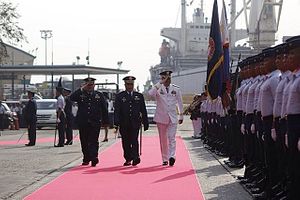Last week, Japan disclosed that, following a change in Japanese law, it will now be donating five aircraft to the Philippines rather than leasing them as previously agreed. Though the move represents just one change in a broader relationship that has already been deepening in the defense realm, its significance for both sides and the wider region ought not to be underestimated.
As I have noted in previous pieces, though relations between Japan and the Philippines date back decades, ties in the defense domain were strengthening significantly under former Philippine President Benigno Aquino III and Japanese Prime Minister Shinzo Abe, in part due to common concerns about China’s growing assertiveness in the East China Sea and the South China Sea. Despite lingering concerns about Philippine President Rodrigo Duterte’s drift toward China, the commitments between Tokyo and Manila have continued and advances are still being made (See: “Japan-Philippines Defense Relations Under Duterte: Full Steam Ahead?”).
In March 2016, the two countries signed a landmark agreement on defense equipment and technology transfer, making the Philippines just the fourth country Japan has ever inked such a pact with and paving the way for more defense-related developments following Tokyo’s lifting of a self-imposed ban on weapons exports. In September 2016, Japan and the Philippines agreed to a deal where JMSDF would lease two aircraft to the Philippines for a year starting in March.
Parts of that bilateral deal are already ongoing. The Philippines received the first two TC-90 aircraft on March 27. And the training of Philippine naval pilots has been underway as well, with the first of three batches of training occurring from November 2016 to March 2017 and the second completed on October 20 at JMSDF Tokushima Air Base. But the Philippines was hoping for a switch from a leasing agreement to free of charge use of the aircraft. That became possible following a change in Japanese law during the last session of parliament, which significantly paved the way for the donating of secondhand defense equipment to developing countries.
On October 23, Japanese Defense Minister Itsunori Onodera reportedly conveyed to Philippine Defense Secretary Delfin Lorenzana during their bilateral meeting at the sidelines of the 4th ASEAN Defense Ministers Meeting-Plus (ADMM-Plus) that Tokyo had decided to officially donate five TC-90s to Manila: the two currently being leased and three upcoming ones.
Though this may seem like a small change, its significance should not be underestimated. As I have noted before, despite some improvements, the Armed Forces of the Philippines (AFP) still remains one of the region’s weakest militaries, and Manila continues to try to boost its capabilities with a limited budget (See: “Where is the Philippines Coast Guard in its Military Modernization?”). In that context, any help that partner countries like Japan can provide is welcome, especially if it is free or at low cost.
More specifically, the TC-90s, as I have noted before, can be deployed for a variety of purposes ranging from disaster response missions to maritime security operations. Manila does not have enough aircraft to conduct regular patrols in the South China Sea, and these planes could be fitted with basic surface and air radar for surveillance as Manila responds to China’s threat to Philippine claims there. With a range of about 1,900 kilometers, the TC-90s will roughly double the area that Philippine aircraft can now patrol.
In addition, this move is no doubt significant for Japan as well. Under Prime Minister Shinzo Abe, Japan has been trying to boost its defense ties with individual Southeast Asian states and ASEAN as a whole (See: “Japan Reveals First ASEAN Defense Initiative With Vientiane Vision”). One of the more challenging areas for this is the transfer of defense equipment, since Japan is a newcomer to this, having just lifted decades-old restrictions.
The TC-90 deal is thus a breakthrough for Japan on this front. The agreement effectively marks the first instance in which excess defense equipment was transferred to another country completely free of charge, proving that Tokyo can in fact make some inroads in the region despite the difficulties of being a newcomer in the defense market, as has been evident in some other cases (See: “Australia-Japan Defense Ties are Deeper than a Sunken Submarine Bid”). It also further cements the Philippines’ role as one of the key countries that Japan can advance defense ties with within the broader Southeast Asian context despite the lingering uncertainties in the Duterte era.

































